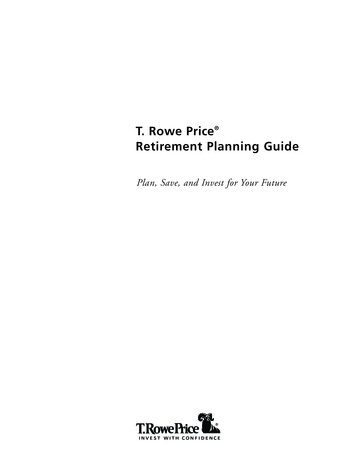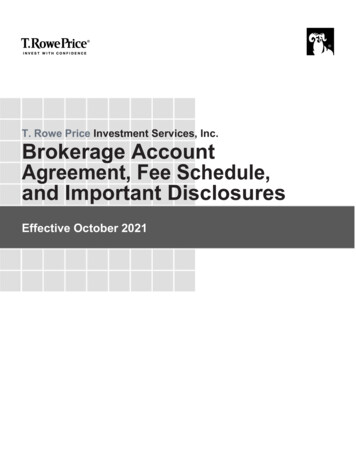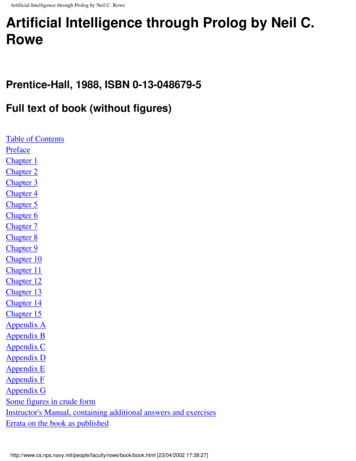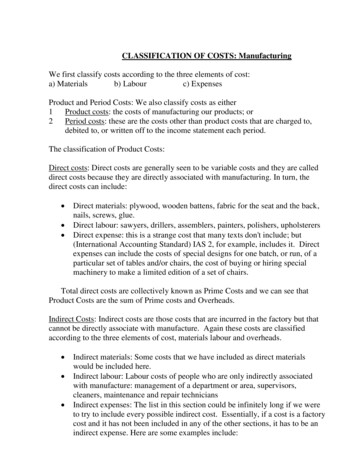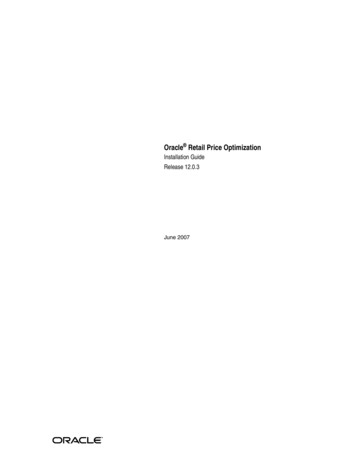
Transcription
T. Rowe PriceINSIGHTS KEY POINTS P H OTO G R A P H B Y H E R O I M A G E SPlan Confidently forRetirement Answers to these 5 questions can help put the future youwant within reach.Saving for retirement represents an important long-term financial goal formost investors. Although your savings strategy will reflect your personalcircumstances and the type of retirement you envision, certain challenges arecommon to nearly everyone. For instance, those still in the workforce frequently want toknow whether they are saving enough for retirement, while retirees often wonder how Although every situationis unique, many investorsshare similar concernsabout saving for retirement.Guidelines can helpinvestors get started evenwhen they’re uncertainabout the future.Investors should regularlyrevisit their strategies andassumptions to keep theirplans and goals aligned.CONTINUED TROWEPRICE.COM1
Plan Confidently for Retirementmuch they can afford to spend. The answers to these common questions may vary fromperson to person, but the following recommendations can help start you down the pathtoward retirement success.1How much should I be saving for retirement?“Exactly how much you need to save depends on several factors, including yourlifestyle, how much you earn, and your unique vision for this next stage of life,” saysJudith Ward, CFP , a senior financial planner with T. Rowe Price. However, by aimingto save at least 15% of your income—including any employer match—you can giveyourself a good chance to maintain your current lifestyle in retirement.Each extra percentage point you save will make a difference in your retirementsavings. (See “Every Little Bit Helps.”) T. Rowe Price’s 15% guideline is based on severalfactors, including the potential that your retirement will last 30 years or longer,exposing you to increased risks from inflation and higher health care costs. A 15%target can help your savings generate a robust income stream in the face of theselong-term challenges. Many individuals may look to their workplace plan, like a 401(k),to set their savings rate. Investors also can supplement these savings with an IRA or aregular, taxable account.2Have I saved enough for retirement so far?Considering you may spend 30 years or more in retirement, it’s important to save enough sothat your money will last. “A quick way to check your progress is to assess how much you’vesaved by certain ages,” says Ward. “We refer to the target levels as savings benchmarks.”Every Little Bit HelpsContributing a few percentage points more each year could make a big difference in yourretirement savings. Saving 15% Saving 10% 2,000,000 1,710,000Amount saved by age 65Retirement Savings1,500,000 570,000The difference between saving15% per year versus 10% per year1,000,000500,000 1,140,000Amount saved by age 6503035404550556065AgeAssumes 7% average annual return in a tax-deferred account, a 50,000 starting salary at age 30, and a3% annual salary increase. The savings estimates are rounded and shown in future dollars. This chart is forillustrative purposes only and does not represent the performance of any specific security. All investmentsinvolve risk, including possible loss of principal.T. R O W E P R I C E I N S I G H T S TROWEPRICE.COM2
Plan Confidently for RetirementYour savings benchmarkTo find your retirement savings benchmark, look for your approximate age and considerhow much you’ve saved so far. (See “Savings Benchmarks by Age.”) Compare that amountwith your current gross income or salary.These benchmarks assume you’ll be dependent primarily on personal savings andSocial Security benefits in retirement. However, if you have other income sources (e.g., apension), you may not have to rely as much on your personal savings, so your benchmarkwould be lower.The midpoint benchmarks are a good starting point, but circumstances vary by personand over time. Key factors that affect the savings benchmarks include income and maritalstatus. Depending on your personal circumstances, you may want to consider otherbenchmarks within the ranges. As you’re nearing retirement, think about analyzing yourspending and income sources more carefully (going beyond benchmarks).3Should I contribute to a Roth IRA or a Traditional IRA?Setting money aside in a Roth individual retirement account (IRA) offers a few distinctbenefits over saving in a Traditional IRA. (See “Comparing IRAs” on page 4.) Inparticular, withdrawals from a Roth IRA are tax-free in retirement (provided you are age59½ or older and have held the account for five years). By comparison, withdrawals fromTraditional IRAs generally are taxed as ordinary income. This difference in taxtreatment means that a Roth IRA offers the potential for greater income flexibility andtax diversification in retirement.Savings Benchmarks by AgeFind your retirement savings benchmark by looking for your approximate age.15 Benchmark Range Approximate MidpointMultiples of Income1211x9x97x65x31x/2 x1030353x2x404550556065AgeAssumptions: Benchmarks are based on a target multiple at retirement age and a savings trajectory overtime consistent with that target and the savings rate needed to achieve it. Household income grows at 5%until age 45 and at 3% (the assumed inflation rate) thereafter. Investment returns before retirement are 7%before taxes, and savings grow tax-deferred. The person retires at age 65 and begins withdrawing 4% ofassets (a rate intended to support steady inflation-adjusted spending over a 30-year retirement). Savingsbenchmark ranges are based on individuals or couples with current household income between 75,000and 250,000. Target multiples at retirement reflect estimated spending needs in retirement (including a 5%reduction from preretirement levels); Social Security benefits (using the SSA.gov Quick Calculator, assumingclaiming at full retirement ages and the Social Security Administration’s assumed earnings history pattern);state taxes (4% of income, excluding Social Security benefits); and federal taxes (based on rates as ofJanuary 1, 2018). While federal tax rates are scheduled to revert to pre-2018 levels after 2025, those ratesare not reflected in these calculations. For the benchmarks, we assume the household starts saving 6% atage 25 and increases the savings rate by 1% annually until reaching the necessary savings rate.T. R O W E P R I C E I N S I G H T S TROWEPRICE.COM3
Plan Confidently for RetirementMoreover, Roth IRAs aren’t subject to the required minimum distributions (RMDs)that apply to most retirement accounts starting at age 70½, so you can let any Roth assetscontinue to benefit from potential tax-free growth for the rest of your life, if you choose.“Roth contributions can be a good choice if you don’t expect your tax bracket to decreasein retirement or if you already have significant Traditional assets and won’t need all ofthose funds for income,” says Roger Young, CFP , a senior financial planner withT. Rowe Price.4Which retirement account should I fund first?The order in which you contribute to your retirement accounts can help increase futurespendable income. Your best contribution order will depend on your personalsituation. When deciding on the right approach, make sure not to miss out on anymatching contributions if offered by your employer’s retirement plan. Also, considertaking advantage of the potential tax-free withdrawals from a Roth account—bothwithin your employer’s retirement plan (if available) and through a Roth IRA (if youmeet income qualifications).*Let’s look at an example: Suppose Roth contributions make sense for your situationand you’re eligible to contribute to a Roth IRA, but your company doesn’t offer a Rothoption in its 401(k) plan. In this case, contribute enough to your Traditional 401(k) toearn any company match, then to a Roth IRA. Then direct any supplemental savings toyour Traditional 401(k) and/or a taxable account, depending on your circumstances andother financial goals.Comparing IRAsWhen it comes to making a thoughtful decision between a Roth IRA and a Traditional IRA,it helps to understand the differences.Traditional IRAsRoth IRAsContributionlimits 6,000 ( 7,000 if age 50 or over) or 100% of taxable compensation, whichever is less,in 2019EligibilityrequirementsMust be under age 70½ and have earnedincome; no income limitsNo age limits; must have earned income;income limits apply*TaxconsiderationsContributions may be tax-deductibledepending on your income; withdrawalsare generally taxableContributions are not tax-deductible;withdrawals are generally tax-freeRequiredminimumdistributionsRequired at age 70½None for the account owner* In 2018 and 2019, eligibility to make the maximum Roth IRA contribution requires a modified adjusted gross income (AGI) of less than 120,000 and 122,000,respectively, for single filers and less than 189,000 and 193,000, respectively, for married couples, filing jointly. (A modified AGI of less than 135,000 and 137,000, respectively, for single filers or less than 199,000 and 203,000, respectively, for married couples is required for partial contributions.)T. R O W E P R I C E I N S I G H T S TROWEPRICE.COM4
Plan Confidently for Retirement5What should I consider when establishing an income plan for retirement?“Starting to draw down your savings can be a challenge after years of putting moneyaside,” says Young. “A strategy that includes a sustainable withdrawal rate and a sequencefor which accounts to draw from can help ensure you make the most of your savings.”T. Rowe Price suggests the 4% guideline as a starting point for a withdrawal strategy.This means that in the first year of retirement, you should look to withdraw up to 4% ofyour retirement account balance and reevaluate your spending needs each year. If youhave multiple retirement accounts, the order in which you make withdrawals can helpyou manage your tax bill and maximize the continuing growth potential of your assets.You’ll want to assess and plan out your strategy well before required minimumdistributions (RMDs) kick in.Also, consider your options for Social Security. You can start taking Social Securitybenefits at age 62, but waiting just a few years until your full retirement age (FRA) willallow you to claim your full benefits. And the longer you wait—up to age 70—the higheryour annual benefit may be. Consider coordinating your claiming strategy with yourspouse. For instance, to maximize the benefit for a surviving spouse, the higher earnershould wait as long as possible before claiming benefits.Finally, remember that, in general, you’ll need to take RMDs from retirement accountsby April 1 of the year after you reach age 70½. (Roth IRAs generally are exempt from theRMD rules.) If you don’t initiate this distribution, you may have to pay a 50% tax penaltyon the amount not withdrawn.For more detailed information, see the full report about various withdrawal strategies attroweprice.com/withdrawalstrategiesreport.T. R O W E P R I C E I N S I G H T S TROWEPRICE.COM5
Plan Confidently for RetirementT. Rowe Price focuses on delivering investment managementexcellence that investors can rely on—now and over the long term.To learn more, please visit troweprice.com.Important InformationThis material material has been prepared by T. Rowe Price for general and educational purposes only. This material does not provide fiduciary recommendationsconcerning investments, nor is it intended to serve as the primary basis for investment decision-making. T. Rowe Price, its affiliates, and its associates do notprovide legal or tax advice. Any tax-related discussion contained in this material, including any attachments/links, is not intended or written to be used, and cannotbe used, for the purpose of (i) avoiding any tax penalties or (ii) promoting, marketing, or recommending to any other party any transaction or matter addressedherein. Please consult your independent legal counsel and/or professional tax advisor regarding any legal or tax issues raised in this material.T. Rowe Price Investment Services, Inc., Distributor.T. Rowe Price, INVEST WITH CONFIDENCE, and the bighorn sheep design are, collectively and/or apart, trademarks of T. Rowe Price Group, Inc. 2019T. Rowe Price. All rights reserved.201904-7986774/19
particular, withdrawals from a Roth IRA are tax-free in retirement (provided you are age 59½ or older and have held the account for five years). By comparison, withdrawals from Traditional IRAs generally are taxed as ordinary income. This difference in tax treatment means that a Roth IRA offers the potential for greater income flexibility and

